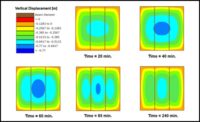Performance-based structural fire design of steel frames can eliminate fire protection on up to half of a building’s floor beams, according to a two-year study of PBSFD. Still, structural engineers leading the way toward more common use of structural fire engineering in the U.S. say there is more testing needed—especially on column-to-beam connection details—to prove all the benefits of PBSFD.
The method, which develops project-specific structural behavior, requires sophisticated modeling of a design under fire loads. PBSFD can “benefit public safety and deliver more efficient and economical buildings,” says Kevin LaMalva, principal fire consultant for Warringtonfire. He was the lead investigator for the research, which produced a 268-page publication, “Performance-Based Structural Fire Design,” released Oct. 6 and available for download free of charge.
Targeted fire protection, applied off site, can improve site conditions, reduce construction schedules and improve quality control. PBSFD also can enhance aesthetics by allowing more exposed structure, the study says. It was organized by the Structural Engineering Institute (SEI) of the American Society of Civil Engineers and the Charles Pankow Foundation, which provided a $230,000 grant.
PBSFD is not covered by the prescriptive provisions of the building code. Each PBSFD project must be approved through the alternate means and methods provision of the code. That takes longer. A next step is to facilitate “explicit” PBSFD provisions into building codes, says Ron Klemencic, chairman and CEO of Magnusson Klemencic Associates, ENR’s 2018 Award of Excellence winner and a Pankow director.
Before that, building and fire officials need to be informed about PBSFD. Toward that end, the Pankow foundation and SEI are developing a webinar, based on the publication, to educate engineers, building and fire officials and architects.
Potential Benefits
The study demonstrates the potential benefits of structural fire engineering—by example. Using PBSFD, each of the four lead firms in the study reanalyzed an existing steel frame, representing a different building type in a different locale. The firms are Simpson Gumpertz & Heger, MKA, Thornton Tomasetti (TT) and Walter P Moore (WPM).
The reduced coverage area necessary for floor-system protection is one of the bigger surprises of the research, says Viral Patel, a WPM senior principal. WPM senior associate Ozgur Atlayan adds: “By making minor changes in our typical composite floor deck details, we can increase the fire resistance of the slabs.”
Another surprise is that, contrary to conventional thinking, restrained conditions—where beams are mechanically fixed to the rest of the structure—are “predominately deleterious” to structural system performance under uncontrolled fire exposure, says LaMalva.
The study also shows how the performance of connections is “critical” to safety in fire, adds Najib N. Abboud, a TT managing principal. Connection design is not broadly understood because it is not covered in standard furnace tests that are relied upon in the prevailing prescriptive design approach, he adds.
Another finding is that the hourly fire rating of structural components does not correspond to how long they will carry their loads in an actual building fire. “These components may fail at a time much shorter or longer than the hourly rating based on the specifics of fire and structural response,” says Abboud.
The research gives U.S. engineers the tools to start playing catch-up with their counterparts in Europe, Australia, New Zealand and Japan, where PBSFD is more commonly used. For example, in the U.S., the 100-year-old method of spraying fire insulation onto the entire steel frame is typical. In the U.K., “more than half of the new steel buildings implement off-site-applied, thin intumescent paint on only select members,” says Atlayan.
Abboud says PBSFD also “brings our design approach in line with what we do for other hazards, such as earthquakes, wind and even terrorism.”





Post a comment to this article
Report Abusive Comment